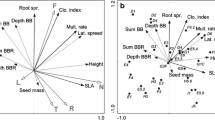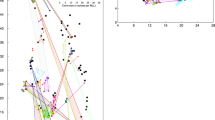Abstract
In this paper we assess the relationship between the frequency of clonal traits and environmental factors in plant communities facing abiotic constraints imposed by an alpine environment. The study was conducted in the Vanoise Massif,inner part of the French Alps, at 1,620 to 2,800 m a.s.l. We sampled 169 communities that encounter a broad set of environmental constraints, and that were distributed over the entire Massif. For all species, we documented clonal traits using data available in the literature (e.g., the CLOPLA database), completed by other sources and our own measurements. Four traits that have previously been shown to be correlated with abiotic stress and disturbances were considered: duration of clonal integration, clonal production, spreading rate, and bud-bank size. Clonal characteristics of plant communities (aggregated traits) along the two main environmental gradients (altitude and duration of snow cover) were assessed. The distribution of clonal traits was significantly but weakly correlated with environmental factors. The duration of clonal integration and bud-bank size increased with altitude, and clonal production decreased. The duration of clonal integration and the size of the bud bank were also higher in snow beds. Scree communities were characterized by a high spreading rate and a large bud bank. The duration of integration was unexpectedly shorter in disturbance-prone habitats, and spatial mobility was unexpectedly higher in one of the most stressed habitats.

Similar content being viewed by others
References
Bertness MD, Ellison AM (1987) Determinants of pattern in a New England salt marsh plant community. Ecol Monogr 57:129–147
Birch CPD, Hutchings MJ (1999) Clonal segmentation – The development of physiological independence within stolons of Glechoma hederacea L. (Lamiaceae). Pl Ecol 141:21–31
Bond WJ, Midgley JJ (2001) Ecology of sprouting in woody plants: the persistence niche. Trends Ecol Evol 16:45–51
Bonnier G (1990) Flore complète illustrée en couleurs de France, Suisse et Belgique. Belin, Paris
Bornard A, Mauro Bassignana A, Bernard-Brunet C, Labonne S, Cozic P (2006) Les végétations d'alpage de la Vanoise – Description agro-écologique et gestion pastorale. Quae, Versailles
Callaway RM, Brooker RW, Choler P, Kikvidze Z, Lortie CJ, Michalet R, Paolini L, Pugnaire FI, Newingham B, Aschehoug ET, Armas C, Kikodze D, Cook BJ (2002) Positive interactions among alpine plants increase with stress. Nature 417:844–848
Chen JS, Lei NF, Yu D, Dong M (2006) Differential effects of clonal integration on performance in the stoloniferous herb Duchesnea indica, as growing at two sites with different altitude. Pl Ecol 183:147–156
Chevenet F, Doledec S, Chessel D (1994) A fuzzy coding approach for the analysis of long-term ecological data. Freshwater Biol 31:295–309
Choler P, Michalet R (2002) Niche differentiation and distribution of Carex curvula along a bioclimatic gradient in the southwestern Alps. J Veg Sci 13:851–858
Combroux I, Bornette G, Willby NJ, Amoros C (2001) Regenerative strategies of aquatic plants in disturbed habitats: the role of the propagule bank. Arch Hydrobiol 152:215–235
Dietz H, Kohler A, Ullmann I (2002) Regeneration growth of the invasive clonal forb Rorippa austriaca (Brassicaceae) in relation to fertilization and interspecific competition. Pl Ecol 158:171–182
Dietz H, Steinlein T (2001) Ecological aspects of clonal growth in plants. Progr Bot 62:511–530
Doak DF, Loso MG (2003) Effects of grizzly bear digging on alpine plant community structure. Arctic Antarct Alpine Res 35:421–428
Dolédec S, Chessel D (1994) Co-inertia analysis – an alternative method for studying species environment relationships. Freshwater Biol 31:277–294
Dray S, Chessel D, Thioulouse J (2003) Co-inertia analysis and the linking of ecological data tables. Ecology 84:3078–3089
Eriksson O (1997) Clonal life histories and the evolution of seed recruitment. In Kroon H, Van Gronendael J (eds) The ecology and evolution of clonal plants. Backhuys Publishers, Leiden, pp 211–226
Eriksson O, Jakobsson A (1998) Abundance, distribution and life histories of grassland plants: a comparative study of 81 species. J Ecol 86:922–933
Fahrig L, Coffin, DP, Lauenroth WK, Shugart HH (1994) The advantage of long-distance clonal spreading in highly disturbed habitats. Evol Ecol 8:172–187
Garnier E, Cortez J, Billes G, Navas ML, Roumet C, Debussche M, Laurent G, Blanchard A, Aubry D, Bellmann A, Neill C, Toussaint JP (2004) Plant functional markers capture ecosystem properties during secondary succession. Ecology 85:2630–2637
Grace JB (1993) The adaptive significance of clonal reproduction in Angiosperms – an aquatic perspective. Aquatic Bot 44:159–180
Halassy M, Campetella G, Canullo R, Mucina L (2005) Patterns of functional clonal traits and clonal growth modes in contrasting grasslands in the central Apennines, Italy. J Veg Sci 16:29–36
Hartmann H (1957) Studien über die vegetative Fortpflanzung in den Hochalpen. Jahresber Naturf Ges Graubündens 86:3–168
Harvey PH, Read AF, Nee S (1995) Why ecologists need to be phylogenetically challenged. J Ecol 83:535–536
Humphrey LD, Pyke DA (1998) Demographic and growth responses of a guerrilla and a phalanx perennial grass in competitive mixtures. J Ecol 86:854–865
Hutchings MJ, Wijesinghe DK (1997) Patchy habitats, division of labour and growth dividends in clonal plants. Trends Ecol Evol 12:390–394
Inghe O (1989) Genet and ramet survivorship under different mortality regimes – a cellular automata model. J Theor Biol 138:257–270
Jonsdottir IS, Callaghan TV, Headley AD (1996) Resource dynamic within arctic clonal plants. Ecol Bull 45:53–64
Jonsdottir IS, Watson M A (1997) Extensive physiological integration: an adaptative trait in resource-poor environments? In Kroon H, Van Groenendael J (eds) The ecology and evolution of clonal plants. Backhuys Publishers, Leiden, pp 109–136
Kammer PM, & Mohl A (2002) Factors controlling species richness in alpine plant communities: An assessment of the importance of stress and disturbance. Arctic Antarct Alpine Res 34:398–407
Kelly CK (1995) Thoughts on clonal integration – facing the evolutionary context. Evol Ecol 9:575–585
Klimeš L (2003) Life-forms and clonality of vascular plants along an altitudinal gradient in E Ladakh (NW Himalayas). Basic Appl Ecol 4:317–328
Klimeš L, Klimešová J, Hendricks R, Van Gronendael J (1997) Clonal plant architecture: a comparative analysis of form and function. In Kroon H, Van Gronendael J (eds) The ecology and evolution of clonal plants. Backhuys Publishers, Leiden, pp 1–29
Klimešová J, Klimeš L (1998) CLOPLA1 (CLOnal PLAnts, version 1) – a database of clonal growth in plants of central Europe. Available at: http://www.butbn.cas.cz/klimes/. Accessed 14 Mar 2008
Klimešová J, Klimeš L (2003) Resprouting of herbs in disturbed habitats: is it adequately described by Bellingham-Sparrow's model? Oikos 103:225–229
Klotz S, Kühn I, Durka W (2002) BIOFLOR – Eine Datenbank zu biologisch-ökologischen Merkmalen der Gefäßpflanzen in Deutschland. Available at: http://www.ufz.de/biolflor/index.jsp. Accessed 14 Mar 2008
Körner C (1999) Alpine plant life. Springer Verlag, Berlin
Kotanen PM (1996) Revegetation following sail disturbance in a California meadow: The role of propagule supply. Oecologia 108:652–662
Kull K (1995) Growth form parameters of clonal herbs. Scripta Bot 9:106–115
Legendre P, Legendre L (1998) Numerical ecology. Elsevier Science, Amsterdam
Lovett Doust L (1981) Population dynamics and local specialization in a clonal perennial (Ranunculus repens). The dynamics of ramets in contrasting habitats. J Ecol 69:743–755
Macek P, Lepš J (2008) Environmental correlates of growth traits of the stoloniferous plant Potentilla palustris. Evol Ecol 22:419–435
Noble IR, Slayter O (1980) The use of vital attributes to predict successionnal changes in plant communities subject to recurrent disturbances. Vegetatio 43:5–21
Oborny B (1994) Spacer length in clonal plants and the efficiency of resource capture in heterogeneous environments: a Monte Carlo simulation. Folia Geobot 29:139–158
Oksanen L, Ranta E (1992) Plant strategies along mountain vegetation gradients – a test of 2 theories. J Veg Sci 3:175–186
Onipchenko VG, Semenova GV, van der Maarel E (1998) Population strategies in severe environments: Alpine plants in the northwestern Caucasus. J Veg Sci 9:27–40
Ozenda P (1985) La végétation de la chaine alpine dans l'espace montagnard européen. Masson, Paris
Parc National de la Vanoise (2000) Travaux scientifiques du Parc National de la Vanoise. Parc National de la Vanoise, Chambéry
Pauli H, Gottfried M, Grabherr G (1999) Vascular plant distribution patterns at the low-temperature limits of plant life – the alpine-nival ecotone of Mount Schrankogel (Tyrol, Austria). Phytocoenologia 29:297–325
Pennings SC, Callaway RM (2000) The advantages of clonal integration under different ecological conditions: A community-wide test. Ecology 81:709–716
Pialot D, Chessel D, Auda Y (1984) Environmental description and multiple correspondence analysis. Compt Rend Acad Sci Paris, Sér 3, Sci Vie 298:309–314
Pokarzhevskaya GA (1995) Morphological analysis of alpine communities of the north-western Caucasus. Folia Geobot 30:197–210
Price EAC, Marshall C (1999) Clonal plants and environmental heterogeneity – An introduction to the proceedings. Pl Ecol 141:3–7
R Development Core Team (2005) R: A language and environment for statistical computing. R Foundation for Statistical Computing, Vienna
Rejmánek M, Rejmánkova E, Holzner W (2004) Species diversity of plant communities on calcareous screes: the role of intermediate disturbance. Preslia 76:207–222
Sammul M, Kull K, Tamm A (2003) Clonal growth in a species-rich grassland: Results of a 20-year fertilization experiment. Folia Geobot 38:1–20
Song MH, Dong M, Jiang GM (2002) Importance of clonal plants and plant species diversity in the Northeast China Transect. Ecol Res 17:705–716
StatSoft (2005) STATISTICA (logiciel d'analyse de données). Version 7.1. Available at: http://www.statsoft.fr
Sutherland WJ, Stillman RA (1990) Clonal growth: insights from models. In Van Groenendael J, Kroon H (eds) Clonal growth in plants: regulation and function. SPB Academic Publishing, The Hague, pp 95–112
Tamm A, Kull K, Sammul M (2001) Classifying clonal growth forms based on vegetative mobility and ramet longevity: a whole community analysis. Evol Ecol 15:383–401
Thioulouse J, Chessel D, Doledec S, Olivier JM (1997) ADE-4: A multivariate analysis and graphical display software. Statist Computing 7:75–83
Thompson FL, Eckert CG (2004) Trade-offs between sexual and clonal reproduction in an aquatic plant: experimental manipulations vs. phenotypic correlations. J Evol Biol 17:581–592
Van Groenendael JM, Klimeš L, Klimešová J, Hendriks R (1996) Comparative ecology of clonal plants. Phil Trans, Ser B 351:1331–1339
Weiher E, Van Der Werf A, Thompson K, Roderick M, Garnier E, Eriksson O (1999) Challenging Theophrastus: A common core list of plant traits for functional ecology. J Veg Sci 10:609–620
Winkler E, Fischer M (2001) The role of vegetative spread and seed dispersal for optimal life histories of clonal plants: a simulation study. Evol Ecol 15:281–301
Acknowledgements
The authors express their thanks to J.P. Jouglet, A. Bornard, C. Brau-Nogué and M. Lambertin, who provided floristic data, and to Gilles Favier for the figure preparation. We also thank G. Loucougaray, J. Pottier, G. Kunstler, L. Klimeš, and two anonymous referees for their helpful comments on the manuscript. The experiments comply with the French current laws on vegetation protection.
Author information
Authors and Affiliations
Corresponding author
Rights and permissions
About this article
Cite this article
Evette, A., Bédécarrats, A. & Bornette, G. Environmental Constraints Influence Clonal Traits of Herbaceous Plant Communities in an Alpine Massif. Folia Geobot 44, 95–108 (2009). https://doi.org/10.1007/s12224-009-9039-8
Received:
Revised:
Accepted:
Published:
Issue Date:
DOI: https://doi.org/10.1007/s12224-009-9039-8




